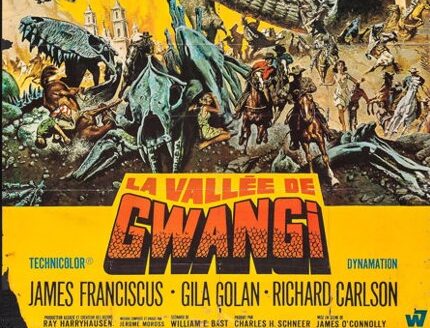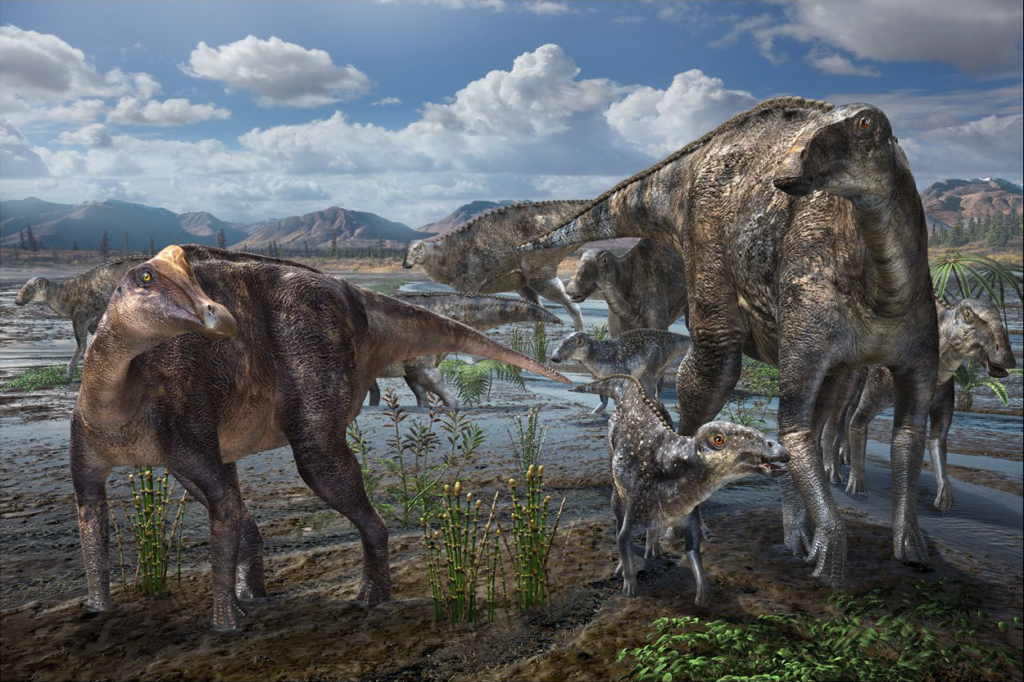Dinosaurs have fascinated humans since the first fossils were discovered, and cinema has long capitalized on our collective obsession with these prehistoric creatures. While blockbusters like Jurassic Park dominate discussions about dinosaur films, many remarkable movies featuring these magnificent beasts have fallen under the radar. These underrated gems offer unique perspectives, innovative storytelling, and memorable depictions that deserve recognition. From animated adventures to gritty sci-fi thrillers, the following films represent some of the most overlooked entries in dinosaur cinema—each bringing something unique to the prehistoric table while receiving far less attention than they deserve.
The Valley of Gwangi (1969)

Despite featuring some of Ray Harryhausen’s most impressive stop-motion work, this stunning blend of Western and dinosaur adventure remains criminally underseen. Set in early 20th century Mexico, the film follows a group of cowboys who discover a hidden valley populated by prehistoric creatures, including the titular Allosaurus “Gwangi.” The meticulous animation brings the dinosaurs to life with surprising realism for the era, particularly during the rope-lassoing sequence where cowboys attempt to capture a living dinosaur. What makes “The Valley of Gwangi” special is not just its technical achievements but its unique genre mashup that creates something wholly original—a dinosaur western that plays like “Jurassic Park” meets “The Magnificent Seven.” The film’s influence extends to modern blockbusters, with Steven Spielberg even paying homage to its rope-capture sequence in The Lost World: Jurassic Park.”
Dinosaur (2000)

Often overlooked in Disney’s animated catalog, Dinosaur represents a technical milestone with its blend of photorealistic backgrounds and computer-animated characters. The film tells the story of Aladar, an Iguanodon raised by lemurs, who must lead a diverse group of dinosaurs to safety after a devastating meteor shower. What makes this film stand out is its visual approach—the production team filmed actual landscapes across the world and digitally inserted the animated dinosaurs, creating a uniquely immersive prehistoric world. The opening sequence, following a dinosaur egg’s journey without dialogue for nearly five minutes, stands as one of Disney’s most ambitious and beautiful pieces of visual storytelling. While the film received criticism for its conventional narrative after the stunning opening, its technical achievements, emotional core, and striking depiction of dinosaur social structures make it worthy of reappraisal by modern audiences.
Journey to the Beginning of Time (1955)

This Czechoslovakian film directed by Karel Zeman demonstrates that groundbreaking dinosaur cinema existed long before CGI revolutionized visual effects. The story follows four boys who travel backward through time, encountering creatures from different prehistoric eras along their journey. Zeman’s innovative combination of stop-motion animation, puppetry, and practical effects created dinosaur sequences that retain their charm and artistry even today. The educational approach sets this film apart from many dinosaur movies, as it carefully depicts creatures from different periods in chronological order, making it both entertaining and informative. The film’s attention to scientific accuracy (for its time) and its sense of wide-eyed wonder influenced generations of paleontology enthusiasts and filmmakers alike. Though rarely screened in North America, this Eastern European classic deserves recognition as one of the most imaginative and well-crafted dinosaur adventures of its era.
Dinosaurus! (1960)

This technicolor B-movie gem boasts a delightfully absurd premise that results in unexpected charm. After a construction project on a Caribbean island accidentally dredges up and revives frozen dinosaurs (a Tyrannosaurus rex and a Brontosaurus) and a caveman, chaos ensues as modern humans interact with these prehistoric visitors. The stop-motion effects by projects veteran Irving Block may not match Harryhausen’s sophistication, but they possess an endearing quality that gives the film its unique character. Particularly memorable is the climactic battle between a steam shovel and the T-rex, representing one of cinema’s earliest “mech vs. monster” confrontations. Despite its low budget and occasional scientific inaccuracies, Dinosaurus! Embraces its outlandish concept with refreshing sincerity and delivers genuine entertainment value. The film’s vibrant color palette and adventurous spirit make it a perfect representation of the dinosaur B-movies that thrived before “Jurassic Park” reset audience expectations.
We’re Back! A Dinosaur’s Story (1993)

This Steven Spielberg-produced animated feature arrived the same year as Jurassic Park” but took a completely different approach to dinosaur storytelling. The film centers on dinosaurs made intelligent by a time-traveling scientist who brings them to modern-day New York to fulfill the wishes of children who want to see real dinosaurs. What distinguishes this film is its imaginative concept and surprisingly mature themes beneath its colorful exterior. The voice cast is extraordinary, featuring John Goodman, Jay Leno, Walter Cronkite, Julia Child, and Martin Short in memorable roles. The film’s most striking element is its visual style, which balances cartoonish character designs with occasionally dark and surreal sequences that give the movie unexpected depth. The Central Park parade sequence and the haunting “Eccentric Circus” segments demonstrate an artistic ambition rarely seen in dinosaur films targeted at younger audiences. Though overshadowed by Spielberg’s other dinosaur project that year, We’re Back!” deserves appreciation for its creative risks and heartfelt message.
The Land Before Time Sequels (1994-2016)

While the original The Land Before Time (1988) is rightfully considered an animated classic, the thirteen direct-to-video sequels are often dismissed without consideration. Looking beyond their more modest animation budgets, several of these sequels contain genuinely thoughtful storytelling and tackle complex themes with surprising sensitivity. The Land Before Time V: The Mysterious Island” explores ecological change and adaptation, while “The Land Before Time VII: The Stone of Cold Fire” delves into questions of faith, skepticism, and cultural beliefs. The consistency of the voice acting across many of the sequels helps maintain character continuity, with performers like Anndi McAfee voicing Cera for over twenty years. The educational value of these films shouldn’t be underestimated either, as they introduce young viewers to different dinosaur species and prehistoric environments while embedding scientific concepts in accessible stories. Though varying in quality, these sequels collectively form one of the most extensive dinosaur franchises in cinema history and deserve recognition for keeping dinosaur stories accessible to generations of children.
Dinosaur Island (1994)

This B-movie takes clear inspiration from Jurassic Park” but adds its own distinctive exploitation film twist. The plot follows a military plane that crashes on an uncharted island inhabited by dinosaurs and a tribe of primitive women. Though marketed to capitalize on the dinosaur craze of the mid-’90s, the film’s practical dinosaur effects possess a handcrafted charm that differentiates it from CGI-reliant productions. The animatronic dinosaurs, including a memorable Tyrannosaurus rex, were created by special effects artist John Carl Buechler, whose work demonstrates impressive artistry despite budget limitations. The film’s over-the-top tone and self-awareness elevate it above similar low-budget fare, as it never pretends to be anything other than campy entertainment. While not appropriate for younger dinosaur enthusiasts due to its adult content, “Dinosaur Island” represents a unique branch of dinosaur cinema that embraces B-movie conventions while delivering genuinely entertaining dinosaur sequences created through traditional practical effects techniques.
Age of Dinosaurs (2013)

This Syfy channel original movie transforms the dinosaur thriller genre into a surprisingly effective disaster film. The story centers on bio-engineered dinosaurs escaping from a corporation in Los Angeles, forcing a firefighter to protect his daughter amid urban dinosaur chaos. While the CGI varies in quality, director Joseph J. Lawson maximizes tension through creative camera work and thoughtful scene composition rather than relying solely on visual effects. The film’s standout quality is its innovative use of Los Angeles locations, particularly during a sequence in the Natural History Museum where modern dinosaurs confront the fossilized remains of their ancestors. Actor Treat Williams brings unexpected gravitas to the lead role, elevating the material through his committed performance. Though often grouped with less ambitious monster movies, Age of Dinosaurs demonstrates how creative filmmaking can overcome budget limitations to create genuinely exciting dinosaur action sequences that pay homage to Jurassic Park while finding their own identity.
Unknown Island (1948)

This early color dinosaur adventure film pioneered many elements that would become staples of the genre despite its relative obscurity today. The plot follows an expedition to a remote island rumored to be home to prehistoric creatures, where the team encounters various dinosaurs and a giant sloth. What makes “Unknown Island” significant is its ambitious use of early Cinecolor technology and its influence on future dinosaur films. The dinosaur costumes, though primitive by modern standards, represent some of the earliest attempts at bringing full-sized dinosaurs to life on screen through practical means. Particularly innovative is the film’s depiction of Ceratosaurus, created through an actor in a full-body dinosaur suit that would influence Japanese Kaiju films in the following decade. Director Jack Bernhard creates several effective sequences through atmospheric direction and creative staging despite technical limitations. As one of the earliest color dinosaur adventure films, “Unknown Island” deserves recognition as a pioneering work that helped establish tropes still used in dinosaur cinema today.
Dinotopia: Quest for the Ruby Sunstone (2005)

This animated adaptation of James Gurney’s beloved Dinotopia book series presents one of the most unique dinosaur societies ever depicted on screen. Set in a world where dinosaurs and humans live together in harmony, the film follows a boy named Kex who discovers Dinotopia and becomes involved in a quest to recover the powerful Ruby Sunstone. What distinguishes this film is its fully realized dinosaur civilization, complete with its orchitecture, customs, educational systems, and transportation networks, all adapted for dinosaur inhabitants. The voice cast includes notable talents like Malcolm McDowell, Alyssa Milano, and Jamie KKennedy, who bring personality to various dinosaur and human characters. The animation style, while not at the level of major studio productions, possesses a colorful charm that captures the imaginative essence of Gurney’s illustrations. As one of the few dinosaur films to present these creatures as civilized beings rather than monsters or simple animals, “Dinotopia: Quest for the Ruby Sunstone” offers a refreshingly different perspective on dinosaur storytelling.
Prehysteria! (1993)

This family-friendly dinosaur adventure delivers surprising heart and creativity despite its modest production values. When a farmer accidentally discovers a nest of miniature dinosaur eggs, his children adopt the hatched baby dinosaurs and hide them from authorities and an unscrupulous museum director. What makes “Prehysteria!” special is its practical puppetry and animatronic work by industry veteran Kevin Yagher, who creates believably expressive miniature dinosaurs including a tiny T-rex, triceratops, stegosaurus, pterodactyl, and brontosaurus. The film cleverly names the dinosaurs after popular musicians—Elvis, Paula, Jagger, Madonna, and Hammer—giving each distinct personality that children can connect with. Director Charles Band, better known for horror films, brings a surprisingly gentle touch to this family film while maintaining enough visual creativity to keep it engaging. Though produced as a direct response to “Jurassic Park” fever, “Prehysteria!” carves its niche by focusing on the bond between children and dinosaurs rather than dinosaur terror, resulting in a charming entry in the dinosaur film genre that spawned two sequels.
Carnosaur (1993)

This Roger Corman-produced alternative to Jurassic Park” takes the dinosaur thriller in a decidedly darker and more horror-oriented direction. The plot involves a mad scientist using genetically engineered dinosaur embryos that can grow inside human hosts, essentially turning the dinosaur film into a biological horror story. What distinguishes “arnosaur” is its commitment to horror elements and its surprising basis in actual (though speculative) scientific theories about dinosaur DNA. The practical dinosaur effects, while limited by budget constraints, achieve several effective moments through selective lighting and creative camera angles. Diane Ladd delivers a memorably unhinged performance as the scientist behind the dinosaur experiments, bringing intellectual credibility to an otherwise exploitative premise. While Carnosaur” cannot compete with “Jurassic Park” in terms of technical achievement, it represents an interesting counterprogramming approach that combines dinosaurs with body horror and apocalyptic themes. The film’s unexpected commercial success led to two sequels, establishing one of the few dinosaur horror franchises in cinema history.
Dinosaur from the Deep (1993)

This Italian-American co-production offers a unique take on the dinosaur thriller by combining elements of detective noir with prehistoric creatures. The story follows a police detective investigating mysterious deaths around Venice’s canals, ultimately discovering a plesiosaur living in the city’s waterways. What makes this film distinctive is its atmospheric European setting, utilizing Venice’s iconic architecture and waterways to create unusual backdrops for dinosaur attacks. Director Lamberto Bava, son of horror legend Mario Bava, brings stylish direction to the proceedings, particularly in underwater sequences that maintain tension despite limited glimpses of the creature. The film’s practical effects, including a full-sized plesiosaur head for close-up encounters, achieve surprisingly effective results through the strategic use of shadows and water reflections. Though the dinosaur appearances are less frequent than in other dinosaur films, the mystery elements and European production design give “Dinosaur from the Deep” a distinctive character that separates it from American dinosaur productions of the same era. This blend of Italian horror sensibilities with dinosaur thriller elements results in a uniquely atmospheric entry in the dinosaur film genre.
Discover Hidden Dinosaur Gems Beyond the Mainstream

The world of dinosaur cinema extends far beyond the boundaries of major franchises like Jurassic Park.” These twelve underrated films demonstrate the remarkable diversity of approaches filmmakers have taken to bringing prehistoric creatures to life on screen. From stop-motion classics and animated adventures to B-movie oddities and horror-tinged thrillers, each offers something unique to dinosaur enthusiasts willing to venture beyond mainstream offerings. What unites these films is their creativity in the face of limitations—whether budget constraints, technological boundaries, or living in the shadow of bigger productions. By exploring these lesser-known dinosaur films, viewers can discover fresh perspectives on these ancient creatures and appreciate the evolution of dinosaur depiction throughout cinema history. The next time you’re browsing for a movie night selection, consider giving one of these overlooked dinosaur gems the attention it deserves.




